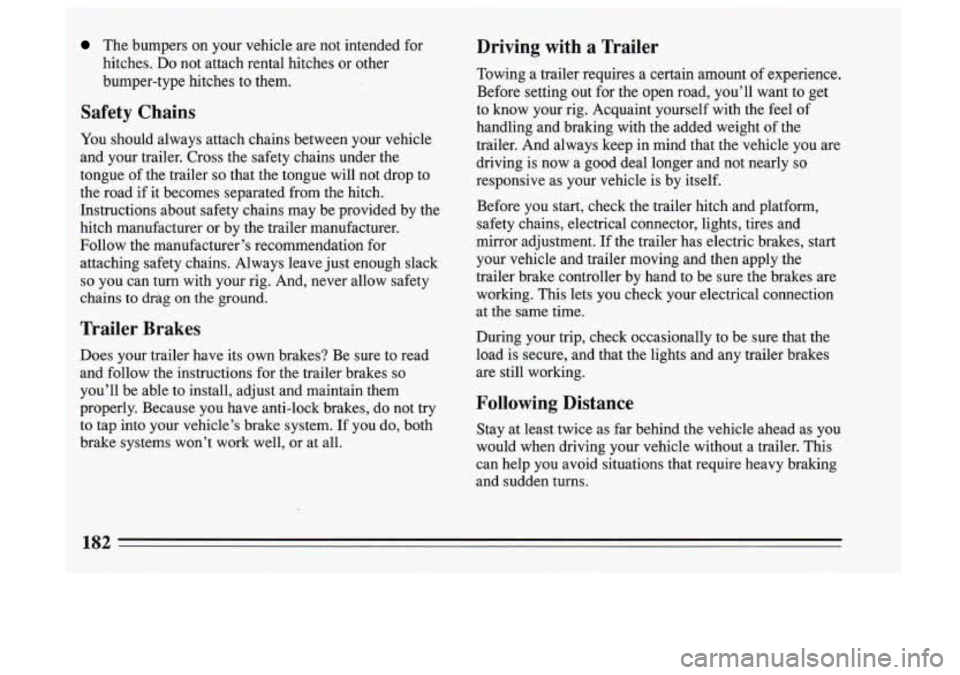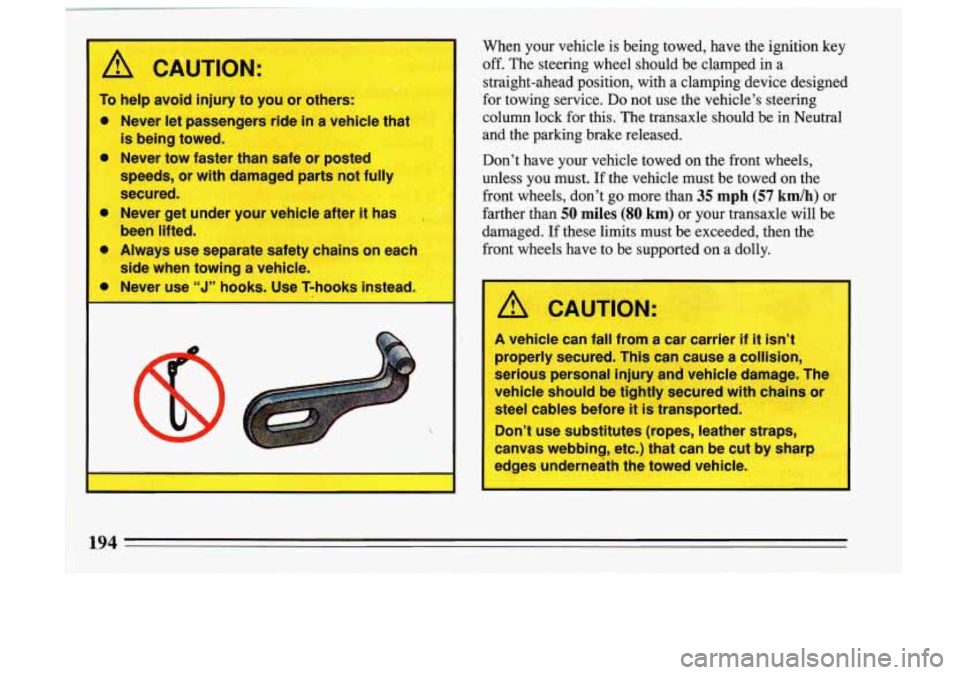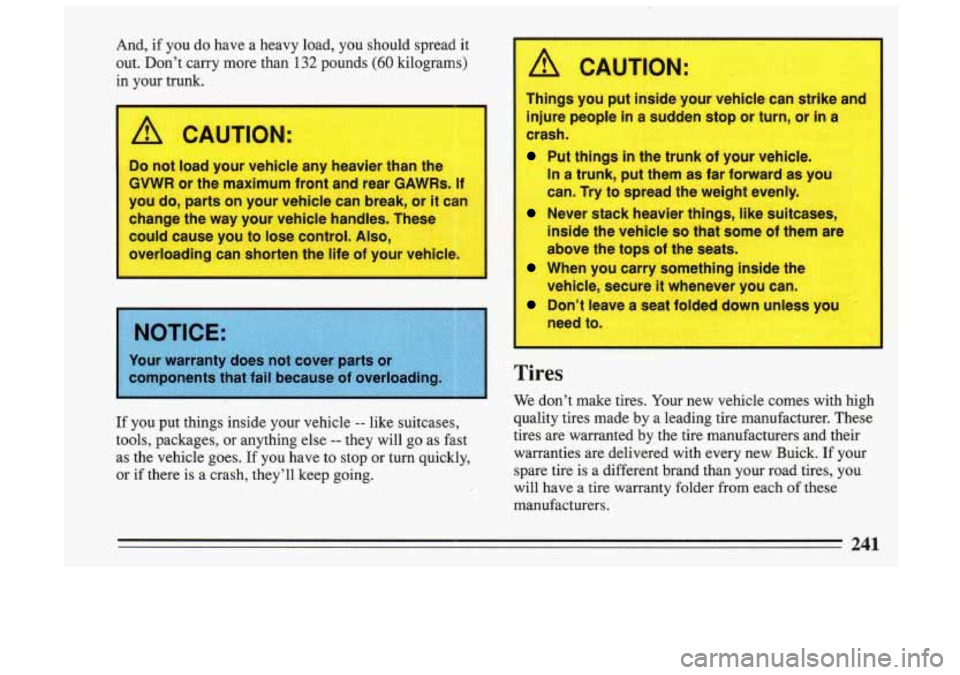1993 BUICK SKYLARK ECU
[x] Cancel search: ECUPage 133 of 306

Step 7. Rotate the TUNE knob right or left to make the
next two numbers agree with your code.
Step
8. Press the BAND AM-FM Knob and “000” will
appear. Now you are ready to enter the second
three
digits of your code.
Step
9. Repeat steps 6 and 7 to enter digits.
Step
10. Press the AM-FM knob and “REP” will appear
for
5 seconds and then “000” will appear.
Step
11. Repeat steps 6 through 10. This time“SEC”
should appear indicating that the radio is secure.
If the
display shows
“ - - - ” , the verification steps .were not
successful and the entire sequence must be started again.
To Unlock The System After a Power Loss
When battery power is reapplied to a secured radio, the
radio won’t turn on and
“LOC” will appear in the
display.
Enter your secret code as follows; pause no more than
15 seconds between steps.
Step
1. Turn the ignition ON. (Radio off.)
Step
2. Press the SET button. The display will show
“000”.
Step 3. Enter the six digits of the code following steps 6
thru 9 as previously indicated. The display will show the
number as entered.
Step
4. Press the AM/FM button and the time appears -
indicating that the disabling sequence was successful. If
the display indicates “SEC ”, the number did not match
and the unit is still secured.
Disabling The Theft System
Step 1. Press preset buttons 1 and 4 for 5 seconds with
the ignition
ON and radio power OFF. The display will
show,“SEC”
, indicating the unit is in the secure mode.
Step
2. Press the SET button. The display will show
“000”.
Step 3. Enter the first three digits of the code following
steps
6 and 7 of the preceding directions. The display
will show the numbers as entered.
Step
4. Press the AM-FM button. The radio will display
“000”.
atep 5. Enter the second three digits of the code. The
display will show the numbers as entered.
Step
6. Press the AM-FM button. If the display shows
- - - ” , the disabling sequence was successful. (The
numbers matched the user-selected code or the factory 66
Page 134 of 306

back-up code) and the unit is in the UNSECURED
mode. If the display shows"SEC", the disabling
sequence was.unsuccessfu1 and the numbers did not
match either of the codes and the unit will remain in the
SECURED mode.
Care of Your Cassette Tape Player
Your tapes will sound best if you clean your cassette
tape player from time to time. Use a non-abrasive
cleaning cassette instead of a music tape. Follow the
instructions on the cleaning cassette.
Store cassette tapes away from extreme heat or direct
sunlight. Protect the open ends from dirt or damage;
store them in their original cases or other protective
cases. Cassettes eventually wear out and you may need
to replace them if they become noisy.
Care of Your Compact Discs
Handle discs carefully. Store them in their original cases
or other protective cases and away from direct sunlight
and dust.
If the surface of a disc is soiled, dampen a
clean, soft cloth in a mild, neutral detergent solution and
clean it, wiping from the center to the edge.
Be sure never to touch the signal surface when handling
discs. Pick up discs by grasping the outer edges or the
edge of the hole and the outer edee.
133
Page 176 of 306

Winter Driving
Here are some tips for winter driving:
Have your Buick in good shape for winter. Be sure
your engine coolant mix is correct.
e Snow tires can help in loose snow, but they may give
you less traction on ice than regular tires. If you do
not expect30 be driving
in deep snow, but may have
to travel over ice, you may not want to switch to snow
tires at all.
YOU may want to put winter emergincy supplies in
your trunk. Include
an ice
scraper, a small brush or broom, a supply
of windshield washer fluid, a rag, some winter outer
clothing,
a small shovel, a flashlight, a red cloth, and a
couple of reflective warning triangles. And, if you will
be driving under severe conditions, include a small bag
of sand, a piece
of old carpet or a couple of burlap bags
to help provide traction.
Be sure you properly secure
these items in your vehicle.
175
Page 183 of 306

The bumpers on your vehicle are not intended for
hitches.
Do not attach rental hitches or other
bumper-type hitches to them.
Safety Chains
You should always attach chains between your vehicle
and. your trailer. Cross the safety chains under the
tongue of the trailer
so that the tongue will not drop to
the road if it becomes separated from the hitch.
Instructions about safety chains may be provided by the
hitch manufacturer or by the trailer manufacturer.
Follow the manufacturer’s recommendation for
attaching safety chains. Always leave just enough slack
so you can turn with your rig. And, never allow safety
chains to drag
on the ground.
Trailer Brakes
Does your trailer have its own brakes? Be sure to read
and follow the instructions for the trailer brakes
so
you’ll be able to install, adjust and maintain them
properly. Because you have anti-lock brakes, do not try
to tap into your vehicle’s brake system. ff you do, both
brake systems won’t work well, or at all.
Driving with a Trailer
Towing a trailer requires a certain amount of experience.
Before setting out for the open road, you’ll want to get
to know your rig. Acquaint yourself with the feel of
handling and braking with the added weight of the
trailer. And always keep in mind that the vehicle you are
driving is now a good deal longer and not.nearly
so
responsive as your vehicle is by itself.
Before you start, check the trailer hitch and platform,
safety chains, electrical connector, lights, tires and
mirror adjustment. If the trailer has electric brakes, start
your vehicle and trailer moving and then apply the
trailer brake controller by hand to be sure the brakes are working. This lets you check your electrical connection
at the same time.
During your trip, check occasionally to be sure that the
load
is secure, and that the lights and any trailer brakes
are still working.
Following Distance
Stay at least twice as far behind the vehicle ahead as you
would when driving your vehicle without a trailer. This
can help you avoid situations that require heavy braking
and sudden turns.
Page 195 of 306

P-
When your vehicle is being towed, have the ignition key
off. The steering wheel should be clamped in a
straight-ahead position, with a clamping device designed
for towing service.
Do not use the vehicle’s steering
column lock for this. The transaxle should be in Neutral
and the parking brake released.
Don’t have your vehicle towed on the front wheels,
unless you must.
If the vehicle must be towed on the
front wheels, don’t go more than
35 mph (57 kmh) or
farther than
50 miles (80 km) or your transaxle will be
damaged. If these limits must be exceeded, then the
front wheels have to be supported on a dolly.
CAUTION:
I A vehicle 1 fall from a car cal t It isn’t
properly secured. This can cause a collision,
serious personal injury and vehicle damage. The
vehicle should be tightly secured with chains or
steel cables before
it is transported.
on’t use substitutes (ropes, leather straps,
canvas webbing, etc.) that can be cut by
sh; 1
I
I edges underneath the towed vehicle.
Page 242 of 306

And, if you do have a heavy load, you should spread it
out. Don’t carry more than 132 pounds
(60 kilograms)
in your trunk.
A CAUTION:
Do not load your vehicle any heavier than the
GVWR or the maximum front and rear GAWRs. If
you do, parts on your vehicle can break, or it can
change the way your vehicle handles. These
could cause you to
lose control. Also, $
overloading can shorten the life of youi-vehicle.
If you put things inside your vehicle -- like suitcases,
tools, packages, or anything else
-- they will go as fast
as the vehicle goes.
If you have to stop or turn quickly,
or if there is
a crash, they’ll keep going.
A CAUTION:
I
Things you put inside your vehicle can strike and I
injure people in a sudden stop or turn, or in a
crash.
Put things in the trunk of your vehicle.
In a trunk, put them as far forward as you
can. Try to spread the weight evenly.
Never stack heavier things, like suitcases,
inside the vehicle
so that some of them are
above the tops
of the seats.
When you carry something inside the
vehicle, secure
it whenever you can.
Don’t leave a seat folded down unless you
need to.
’
I
I
Tires
We don’t make tires. Your new vehicle comes with high
quality tires made by a leading tire manufacturer. These
tires are warranted by the tire manufacturers and their
warranties are delivered with every new Buick. If your
spare tire is a different brand than your road tires, you
will have a tire warranty folder from each of these
manufacturers.
241
Page 299 of 306

Jacking up the Car ............................ .. 204
Jump Starting
................................... 188
Keys
........................................... 62
Keyless Entry System. Remote
...................... 67
Kilometer Indicator
.............................. 108 Label.
Service Parts Identification
.................. 257
Lane Change Indicator
............................. 89
LapBelt
........................................ 42
Lap-Shoulder Belt Usage by Children
................. 58
Latches. Front Seatback
............................ 19
Leaving Your Vehicle
.............................. 83
Light. Safety Belt ................................. 28
Light. Turn Signal Indicator
......................... 89
Light Bulbs. Replaceable
.......................... 262
Lighter. Cigarette
................................ 106
Lights Daytime Running
............................. 100
Interior
...................................... 99
Interior Delay
................................ 102
Operation
..................................... 99
Reading
..................................... 101
Traffic ...................................... 143
Lights “On” Warning
............................. 100
Loading Your Vehicle
............................ 240
Locks. Automatic Door
............................ 65
Locks. Door
..................................... 63
Locks. Rear Door Security
.......................... 69
Long Distance Driving
............................ 168
Loss of Control
................................. 158
Low Coolant Warning Light
....................... 113
Low Oil Pressure Warning Gage
.................... 114
298
Page 301 of 306

Power Antenna
..................................... 134
Door Locks
................................... 65
Seat Controls
................................... 16
Steering
..................................... 154
Windows
..................................... 87
Pregnancy. Use
of Safety Belts During ................ 35
Pressure. Tire
................................... 242
Problems on the Road
............................ 185
Publications. Service
............................. 288
Publications Order Form .......................... 291
Push-Starting Your Car
........................... 188
Steering
Fluid
................................ 234
Proper Safety Belt Usage for Adults
.................. 28
Racing. Shifting When Your Engine is
............... 78
Radiator Overheating
............................. 197
Radio. Adding a Two-way
......................... 123
Radio Systems
.................................. 122
Rain. Driving in
................................. 161
Reaction Time
in Braking ......................... 149
Reading Lights
.................................. 10 1
RearBrakes .................................... 153
Rear Door Security Lock
........................... 69
Rear Safety Belt Comfort Guides
.................... 40
Rear Seatbacks. Folding
............................ 20
Rear Window Defogger ........................... 121 Reclining Front Seatbacks
.......................... 16
Recommended Fluids and Lubricants
................. 281
Recovery. Off-Road
.............................. 156
Recreational Vehicle Towing
....................... 179
Remote Fuel Door Release
.......................... 219
Remote Keyless Entry System
....................... 67
Remote Trunk Release
............................. 66
Remote Trunk Release Lockout
...................... 66
Replaceable Light Bulbs
.......................... 262
Replacing Brake System Parts
...................... 237
Replacing Safety Belts
............................. 60
Replacing Tires
................................. 244
Replacing Wheels
............................... 247
Restarting Your Car When It’s Moving
................ 78
Restraint. Child
.................................. 46
Restraint Systems. Checking Your
.................... 59
Restraints. Head .................................. 18
Reverse Gear Position
............................. 78
Ride Control System. Adjustable
..................... 86
“Riding” the Brakes
.............................. 149
Roads. Hill and Mountain
......................... 170
Rocking Your Vehicle
............................ 213
Rotation. Tire
................................... 243
Run (Ignition Key Position)
......................... 73
Running Your Engine While You’re Parked
............ 85
Reporting Safety Defects
.......................... 287
Roadsigns
..................................... 138
Running Lights. Daytime
.......................... 100